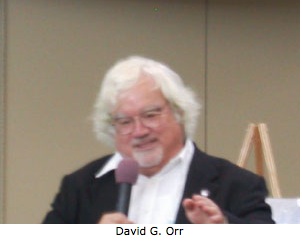David Orr
David Orr has been working in Philadelphia and its environs since 1973 when he moved to Delaware from Rome, Italy to take a position in the American Civilization Department at the University of Pennsylvania. Before this, Orr received his graduate degrees in History and Classical Archaeology at the University of Maryland where he studied under the noted Pompeianist Wilhelmina Jashenski. As an undergraduate he worked two long summer archaeological seasons for the old River basin Surveys of the Smithsonian Institution where he was trained in the rudiments of prehistoric archaeology and participated in important excavations of Arikara villages and early archaic and woodland sites.

During the 1960’s and 1970’s he excavated and conducted research in Pompeii, completing his dissertation on the archaeological sources of Roman domestic religion in 1972. He received the prestigious Prix-de-Rome at the American Academy in Rome and was in residence there for two years.
In 1973 he turned his attention to the American fields of industrial and historical archaeology, folklore and folklife, popular culture and material culture at the University of Pennsylvania. Orr taught the first graduate course in industrial archaeology in the country while at Penn and assisted in two local excavations with his colleague Dr. John Cotter.
When Cotter retired in 1977 from the Mid-Atlantic Region of the National Park Service headquartered in Philadelphia, Orr replaced him as Chief Archaeologist of the region. In various capacities he worked for the NPS out of Philadelphia from 1977 until 2006 when he left the NPS to assume a full time teaching job at Temple University where he presently works.
From 1982 until 2007 Orr taught at the University of Delaware part time and sat on the Delaware State Review Board for the National Register for two terms. Working at Gettysburg, Petersburg, Fredericksburg, Fort McHenry, Fort Necessity, and Yorktown among many other sites in the NPS he early on acquired an enduring interest in the field of Battlefield Archaeology. At City Point, Virginia he excavated during the summers of 1983 and 1984, discovering the site of General Ulysses S. Grant’s headquarters cabin, a late seventeenth and mid-eighteenth century domestic site, and numerous prehistoric sites from the earliest period until the seventeenth century.
During his period with the NPS Orr introduced and implemented a summer intern program with the students of Steve McCarter at Lower Merion High School from 1980-1992. This culminated with a visit to China in 1987 as a member of People to People. Continuing his interest in things Roman he co-directed an Earthwatch project in both Pompeii (1994-97) and nearby Cumae (1999-2001). He was a founding member of the Vernacular Architecture Forum, the Fields of Conflict International Battlefield Archaeological group, the Philadelphia Archaeological Forum (where he served as the first president) and the Oliver Evans Chapter (Philadelphia) of the Society for Industrial Archaeology (where he also served as first president). He participated in two large NEH grants; one centered at Hagley Museum in Delaware and the other in both Canada and Philadelphia.
From his first arrival in Philadelphia he has been bewildered by the rich resources of the area: excavating at Mill Creek, 310 Cypress Street, Woodlands, Point Breeze Gas Works (a HAER project with Penn student Herbert Levy), Rittenhouse Town, numerous sites in South Philadelphia, Elfreth’s Alley, Moravian Street, Edgar Allan Poe House, Area F in Independence National Historical Park, and many other places. His students from both Penn, Delaware, and now Temple have made important contributions to the field. He is currently active in sites such as Graeme Park, the Henry Muhlenberg House in Trappe, Bonnin and Morris porcelain factory, and Timbuktoo, an African-American community. in New Jersey. He has led or conducted more excavations and research projects in Valley Forge than any other individual and has been active there from 1973 until the present.
Orr is presently a member of the Jamestown Discovery Board chaired by Dr. William Kelso, and is a commissioner of Historic St. Mary’s City in Maryland. He has published numerous books and articles the most recent being a compendium of the work and life of John Cotter called Witness to the Past and an anthology on the archaeology of the American Civil War (Huts and History). He is extremely active in local public archaeological functions and emphasizes this concept in all of his teaching. Two future books include another anthology on Philadelphia area archaeology and a material culture based memoir of his childhood in Warren, Ohio called Some Things of Value: A Child Confronts his Material World. He was recently given a Lifetime Preservation Award by New Castle County Delaware, where he currently abides.
Trying to unearth a piece of Timbuctoo history by: MARK ZIMMARO Burlington County Times
Witness to the Past: The Life and Works of John L. Cotter by Daniel G. Roberts and David G. Orr
“Cabin in Command: the Headquarters Cabin of Ulysses S. Grant at City Point” in Huts and History: the Historical Archaeology of
American Military Encampment During the Civil War, Clarence Geier and David G. Orr editors, University Press of Florida, 2006.
“The Ethnography of Big Mac” in Ronald Revisited, edited by Marshall Fishwick, Popular Press, Bowling Green University. 1983.
Posted in Uncategorized by admin